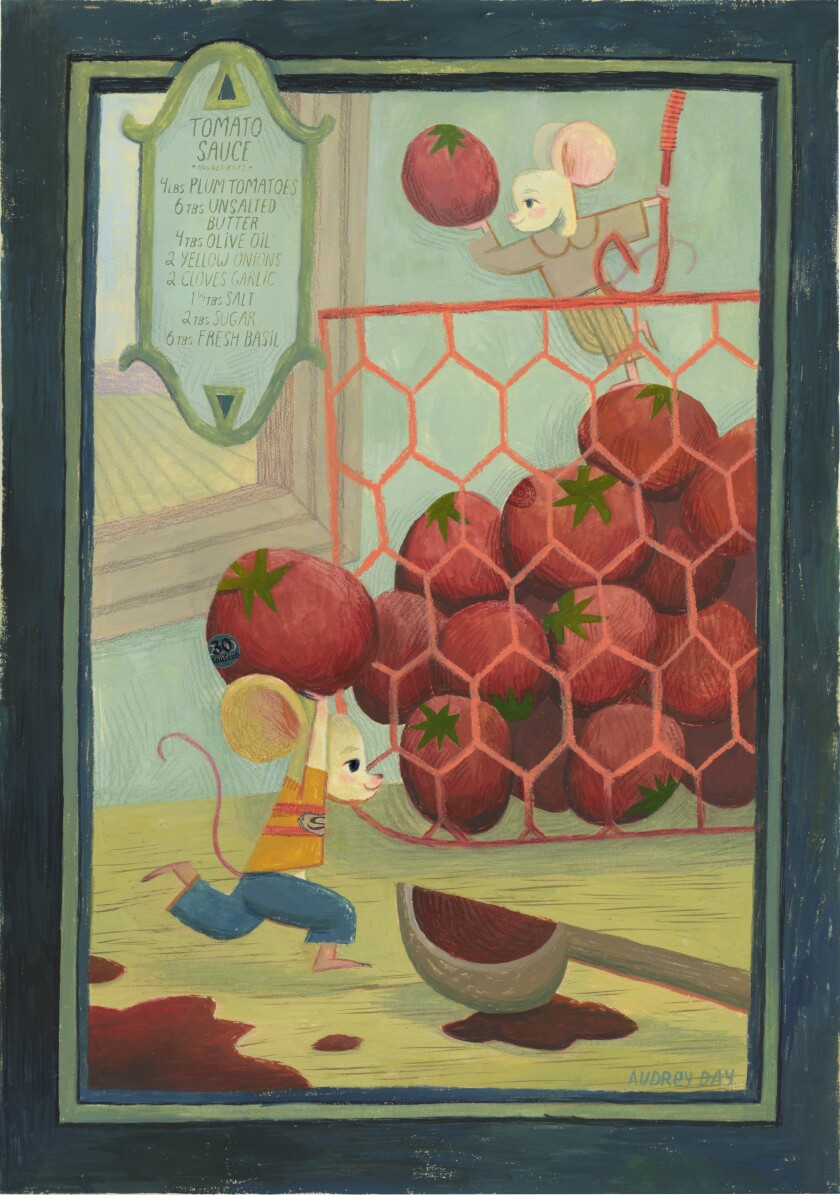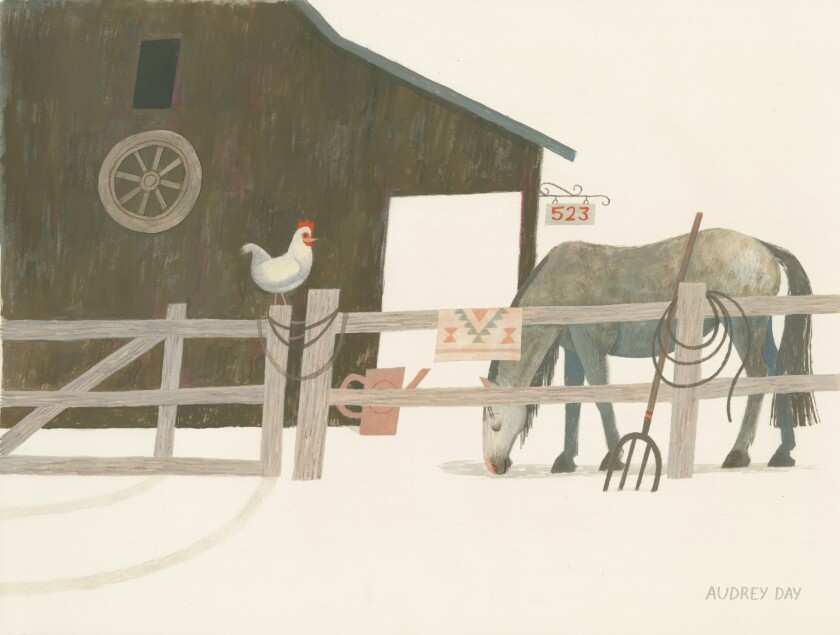Audrey White Day (BFA ’22) Is Returning to BYU as an Adjunct Professor and Has Spent Her Post-Grad Career Illustrating Children’s Literature
Department of Design alum Audrey White Day expertly used her BFA showcase to launch her career as an illustrator. After inviting as many publishers and industry leaders as she could to her showcase, Day secured an agent and has been illustrating children’s books and magazines ever since. This fall semester, Day will return to the Department of Design as an adjunct professor to teach design and composition classes for pre-majors.
Day speaks on children’s literature as a medium, the difference between traditional and digital design, her personal style and advice she’d give to up-and-coming design students.
Q: Do you primarily focus on children’s illustrations and what do you enjoy about that medium?

Day: At BYU, there are two main tracks you can follow in illustration: the digital, concept art route and the traditional, children’s book art route. If careers didn’t exist and specialization didn’t matter, then I would do everything. When I list my dream jobs, it goes through every design and artistic job.
I really like children’s books as a medium because it's like you are a movie director and an artist at the same time. I like how self-directed freelance work is and how you have complete power over how you tell a story. The constraints of the children’s book are nice because, in most cases, you have to have 32 pages and a dust jacket to tell a story. It's a really interesting combination of design problem-solving and fine art work.
Right now I’m focusing on traditional work and moving away from digital work. I only want to use digital tools as a final touch-up rather than most of the process.
Q: What is the process of being a working illustrator?
Day: I’ve only worked on three published children’s books so far. Typically my agent will let me know that there is a project that they think I would be good for. When you’re just starting out as an illustrator, it is very rare to do author-illustrator projects, where you are both the author and illustrator. It’s more common to be hired as an illustrator for a project that already exists. Publishers will look at your portfolio on your agency website and work with you through your agent.
Q: How did you find an agent?
Day: During my time at BYU, I did the email equivalent of cold-calling a lot of people. I invited a lot of people to my BFA showcase; art directors, publishers, anyone who seemed relevant to my career or who may be interested in my show. Honestly, I think only 2% of them got back to me. However, one of the people who got back to me was a publisher at HarperCollins. I did a video walk through of my show for her and sent her some photos. She loved my art and helped connect me with an agent, who I signed with a month or two after my show. So, I was introduced to my agent through all those emails I had sent out for my BFA showcase.

If students don’t invite [publishers and industry professionals] to their BFA show, they should. It’s a perfect opportunity to show them your resume on a large scale.
Q: Do you have a particular project that has been your favorite to work on so far?
Day: I really enjoy all the projects I’ve done for the Friend Magazine. They give me a lot of creative freedom, and I get so excited to see my art in real life. I have little cousins who will call me after getting their subscription and say, “I recognized your art!” The fact that a little kid can recognize my art without knowing that it was me or without seeing my name, that is really fun for me. It reaffirms to me that I have a definite style.
I also really enjoyed working on my own book called “We Are Horses.” I made it as part of my master’s program at Cambridge School of Art. In that program, we were writing and illustrating everything we made. I took it to the Bologna Book Fair in Italy to pitch it to different publishers. It was taken to six different acquisition meetings but ultimately wasn’t picked up for publication. Even though it hasn’t worked out yet, I still really enjoyed working on it.
Q: What three words would you use to describe your illustration style?
Day: Nostalgic, warm and whimsical.

Q: What inspires you?
Day: Everyday life and nature is inspiring. I’m really drawn to old shapes—old cars, old typography, old graphic design. I’m also really inspired by scenes that are very graphic. For example, when I’m on a road trip and I come to a landscape that is flat with sagebrush and nothing else around or if there is a small hill and a farmhouse in the distance. I love stark, contrasting landscapes and graphic compositions.
I’m also inspired by interesting, playful shapes. I care a lot about shapes, maybe a little more than other artists. A lot of artists focus a lot on line quality whereas I take all that energy and focus it on shapes.
Q: How did you discover your design identity?
Day: I think your personal style is anything you can’t run away from in your work. It’s the thing that you try to stop doing but can’t stop doing. Your style is like your handwriting, you just can’t get away from it. It’s so engrained deep in you. I think many people spend a lot of time thinking about their style when style actually comes naturally when you’re working hard. A distinct style is just a byproduct of years and years of hard work.
If you want to be more deliberate about finding your style and you have a specific market or genre you’re aiming for, I would suggest finding your three to five heroes in that niche and running towards them. Don’t worry about having to be unique or reinventing the wheel. No one has reinvented the wheel in art. Design is a conversation between decades of styles and artists. You don’t have to worry about making something completely original. Just run towards your heroes, run towards the art that you love. Meanwhile, you can’t run away from your own style so you’ll end up making unique art naturally.
Q: What is the most valuable lesson you learned while at BYU?
Day: What I’m about to say may sound dumb but it was so profound to me. My professors tried to pound this into our heads while we were at school but I don’t think I fully understood until I was working in the industry: Do the work you want to do.
You get hired to do work and you can’t avoid that so first of all, make sure those jobs are actually things you want to do. And also assign yourself your dream projects, your “guilty pleasure” projects. Why wait? You’re not going to get hired to do that work if you don’t show the world that you are the person for that job.
Q: What advice would you give other illustrators or design students?
Day: If I could talk to my younger self again, I would say to not be afraid that your art is too weird. Don’t be afraid to “weird up” your art. You have this time in school to learn and mess up and get feedback. Just take that time to experiment, try everything and mess up.


